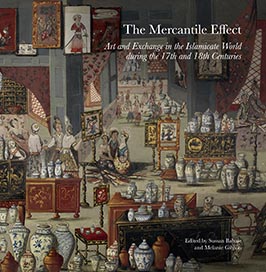
The Mercantile Effect Art and Exchange in the Islamicate World during the 17th and 18th Centuries
این مجموعه زیبا شامل ده مقاله با موضوعات جذاب است که هر یک، تاثیر مبادلات بین فرهنگی در قرن ۱۷ و ۱۸ را بررسی کرده و تاثیر آن بر آسیای غربی در اوایل دوران مدرن را توضیح می دهند.
نویسندگان این اثر، ابتدا تحقیق خود را در سومین کنفرانس Gingko که در نوامبر ۲۰۱۶ در دانشگاه Barenboim-Said Akademie, Berlin برگزار شد، ارائه کردند.
‘The Mercantile Effect captures unexpected glimpses of a vast and shifting landscape and brings them into focus; this is what the future of art history looks like.’
— George Manginis, Academic Director of Benaki Museum, Athens
‘This fine collection of stimulating essays is a fascinating introduction to some of commodities, tastes and ideas that flowed around the Middle East in the premodern era and proves once again how the study of small-scale artefacts and even everyday items powerfully adds to the larger story of trade and exchange.’
— Julia Gonnella, Director, Museum of Islamic Art, Doha
This beautifully illustrated volume publishes a group of papers delivered at the third Gingko conference: ‘The Mercantile Effect: on Art and Exchange in the Islamicate World during 17th-18th Centuries.’ Held in Berlin in 2016, this meeting brought together a group of established and early-career scholars to discuss how the movement of Armenian, Indian, Chinese, Persian, Turkish and European merchants and their trade goods spread new ideas and new technologies across Western Asia in the early modern era. Operating through the newly-established Dutch, English and French East India companies, as well as much older mercantile networks, prestigious exotic commodities: silk, ivory, books and glazed porcelains were transported east and west. The collected essays in this volume introduce a fascinating array of subjects, all of them indicative of the impact of transcultural exchanges during the 17th and 18th centuries.
Sussan Babaie is Andrew W. Mellon Reader in the Arts of Iran and Islam, The Courtauld Institute of Art in London.
Melanie Gibson is Senior Editor of the Gingko Library Art Series.
Table of Contents:
Foreword by Melanie Gibson
Introduction by Sussan Babaie The Mercantile Effect: On Art and Exchange in the Islamicate World
Suet May Lam – Fantasies of the East: ‘Shopping’ in Early Modern Eurasia
Amy S. Landau – The Armenian Artist Minas and Seventeenth-Century Notions of ‘Life-Likeness’
William Kynan-Wilson – ‘Painted by the Turcks themselves’: Reading Peter Mundy’s Ottoman Costume Album in Context
Nicole Kançal-Ferrari – Golden Watches and Precious Textiles: Luxury Goods at the Crimean Khans’ Court and the Northern Black Sea Shore
Nancy Um – Aromatics, Stimulants, and their Vessels: The Material Culture and Rites of Merchant Interaction in Eighteenth-Century Mocha
Federica Gigante – Trading Islamic Artworks in Seventeenth-Century Italy: the Case of the Cospi Museum
Anna Ballian – From Genoa to Constantinople: The Silk Industry of Chios
Christos Merantzas – Ottoman Textiles Within an Ecclesiastical Context: Cultural Osmoses in Mainland Greece
Francesco Gusella – Behind the Practice of Partnership: Seventeenth-Century Portuguese Devotional Ivories of West India
Gül Kale – Visual and Embodied Memory of an Ottoman Architect: Travelling on Campaign, Pilgrimage and Trade Routes in the Middle East
Contributors
لطفا نظر خود را در مورد این مطلب بنویسید
نظرات شما
نظری برای این مطلب ثبت نشده است
مشاهده بیشتر
اطلاعات تماس
با عضویت در خبر نامه
از آخرین مطالب ما، باخبر شوید...